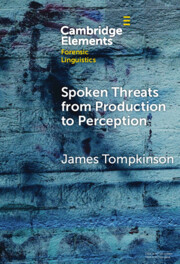Element contents
Spoken Threats from Production to Perception
Published online by Cambridge University Press: 20 December 2023
Summary
- Type
- Element
- Information
- Series: Elements in Forensic LinguisticsOnline ISBN: 9781009292986Publisher: Cambridge University PressPrint publication: 18 January 2024
References
- 5
- Cited by



